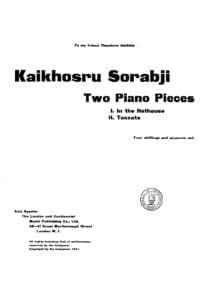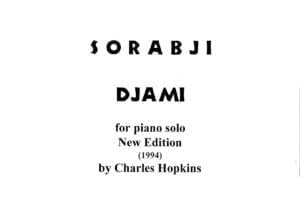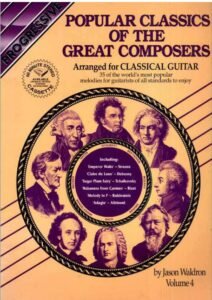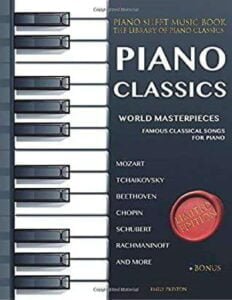Table of Contents:
Sorabji Sheet Music Library #smlpdf

Best Sheet Music download from our Library.
Sorabji Pastiche On Chopin Op 64 1 Minute Waltz
Sorabji Piano Sonata No. 2
Sorabji – Désir Éperdu
Sorabji – 4 Frammenti Aforistici
Sorabji – Grieg La morte d’Ase Variazione maliziosa
Sorabji – Toccatinetta
Sorabji – Two Piano Pieces
Sorabji 2 Piano Pieces
Sorabji Djami
Sorabji Etude 01
Sorabji Etude 17
Sorabji Fantasie Espagnole 1919
Sorabji Piano sonata no 1
Sorabji Salome
Please, subscribe to our Library. Thank you!

Kaikhosru Shapurji Sorabji – In the Hothouse for Piano (1918) [Score-Video]
Kaikhosru Shapurji Sorabji – In the Hothouse for Piano (1918) Steven Max, piano

Please, subscribe to our Library. Thank you!

Kaikhosru Shapurji Sorabji
Kaikhosru Shapurji Sorabji (born Leon Dudley Sorabji; 14 August 1892 – 15 October 1988) was an English composer, music critic, pianist and writer whose music, written over a period of seventy years, ranges from sets of miniatures to works lasting several hours.
One of the most prolific 20th-century composers, he is best known for his piano pieces, notably nocturnes such as Gulistān and Villa Tasca, and large-scale, technically intricate compositions, which include seven symphonies for piano solo, four toccatas, Sequentia cyclica and 100 Transcendental Studies. He felt alienated from English society by reason of his homosexuality and mixed ancestry, and had a lifelong tendency to seclusion.
Sorabji was educated privately. His mother was English and his father a Parsi businessman and industrialist from India, who set up a trust fund that freed his family from the need to work. Although Sorabji was a reluctant performer and not a virtuoso, he played some of his music publicly between 1920 and 1936. In the late 1930s, his attitude shifted and he imposed restrictions on performance of his works, which he lifted in 1976.
His compositions received little exposure in those years and he remained in public view mainly through his writings, which include the books Around Music and Mi contra fa: The Immoralisings of a Machiavellian Musician. During this time, he also left London and eventually settled in the village of Corfe Castle, Dorset. Information on Sorabji’s life, especially his later years, is scarce, with most of it coming from the letters he exchanged with his friends.
As a composer, Sorabji was largely self-taught. Although he was attracted to modernist aesthetics at first, he later dismissed much of the established and contemporary repertoire. He drew on such diverse influences as Ferruccio Busoni, Claude Debussy and Karol Szymanowski and developed a style blending baroque forms with frequent polyrhythms, interplay of tonal and atonal elements and lavish ornamentation.
Though he composed mostly for the piano and has been likened to the composer-pianists he admired, including Franz Liszt and Charles-Valentin Alkan, he also wrote orchestral, chamber and organ pieces. His harmonic language and complex rhythms anticipated works from the mid-20th century onwards, and while his music remained largely unpublished until the early 2000s, interest in it has grown since then.
Biography
Kaikhosru Shapurji Sorabji was born in Chingford, Essex, England on 14 August 1892; his father was a Zoroastrian Parsi civil engineer and his mother English (for a long time, until the work of Sean Vaughan Owen, she was reputed to be part Sicilian, part Spanish). He spent most of his life in England. From his early ’teens he developed an insatiable appetite for the latest developments in contemporary European and Russian music and went to great lengths to obtain the latest scores of such composers as Mahler, Debussy, Schönberg, Skryabin, Rakhmaninov and others at a time and in a country where almost all such music was largely unknown and unrecognized. Of an independent and uniquely curious nature, it is perhaps unsurprising given the pre-War English environment that his education, both general and musical, was mostly private.
For a composer as prolific as he was soon to become, he was an unusually late developer and his voracity in absorbing all the most recent trends in other people’s music seems to have excluded from his mind the idea of making his own until he reached his twenties.
A close friend and confidant of the English composer Philip Heseltine from 1913, Sorabji wrote to him that he was considering a career as a music critic. Once he had begun to compose, however, the floodgates of his imagination burst and a tremendous river of musical creativity flowed forth almost uninterrupted until the early 1980s.
An intensely private person who loathed to participate in public gatherings of any sort, he performed some of his own piano works on rare occasions and with considerable success, most notably in the 1930s in Erik Chisholm’s historic Glasgow-based Active Society for the Propagation of Contemporary Music concert series. Sorabji’s final concert appearance (1936) may have coincided with a decision to withdraw his work from the concert platform by vetoing public performances without his express consent, an unusual and courageous step that led to virtual silence for almost 40 years, declaring that he considered them unsuited to conventional concert performance and that “no performance at all is vastly preferable to an obscene travesty”. While he never actually imposed an unequivocal “ban” on public performances of his works, as used to be claimed, the result was that concert-goers around the world heard almost none of his music for nearly four decades. In view of the colossal difficulties involved in performing much of his music, it was not unexpected that this regrettable situation would continue almost unchallenged for so long.
In the intervening years, Sorabji worked as a critic for The New Age and The New English Weekly until his retirement in 1945; he also continued composing richly expressive and extraordinarily elaborate music at a furious pace, mostly for the piano, without the slightest care as to whether or not it might ever reach the ears of the public.
He resented the intrusion of casual inquirers about himself and his work, as a result of which many entries on him in major music lexica were more notable for their conflict than for the reliability of their information about him. As a result, some of those who remembered his continued existence but knew little or nothing of what he was doing and why, chose — almost inevitably, one supposes — to spin webs of myth and legend about him. These tell more about their creators than they do about Sorabji. It has taken some years to wipe away the fatuous “Howard Hughes of Music” image of him which had been fostered by some who had little better to do.
He lived quietly and modestly in London and then in South Dorset in self-chosen isolation, undisturbed by the mêlée of professional public music-making. He had the good fortune of a small private income which allowed him this existence and permitted him to get on with his work uninhibited and undisturbed.
From 1976, the pioneering efforts of South African pianist Yonty Solomon began to turn the history of Sorabji’s reputation. In a monumental series of London recitals, he presented a number of Sorabji’s piano works for the first time and the interest which these generated has grown and developed ever since. This inevitably led to increasing international interest in his music; following Solomon’s pioneering, more performers presented authorised performances, broadcasts and commercial recordings, laying to rest at last the long-held myth of its unplayability. In suitable conditions, Sorabji permitted — even encouraged — this, once he recognised the existence of musicians capable of doing it justice. Cognoscenti of the major keyboard works do not predict such compendia of fearsome difficulties becoming “standard repertoire”, but whilst the music hurls uniquely forbidding challenges at performers, it exerts an immediate intellectual and emotional grip on listeners.
The 1980s witnessed, among other performances, an astonishingly accurate and powerful première of Sorabji’s two-hour Organ Symphony No. 1 (1923–24) and an absolutely stunning account of all four-and-three-quarter hours of his piano work Opus clavicembalisticum (1929–30), which proved to be the crowning glory of John Ogdon’s career. Further major premières have followed since.
Following Sorabji’s death at the age of 96, a series of CD recordings began to appear, including the two works mentioned above. The Sorabji Archive has encouraged major performers and scholars to create fine new editions of the composer’s works from his manuscripts.
International artists of distinction who have performed, broadcast and recorded Sorabji’s music include pianists Yonty Solomon, John Ogdon, Marc-André Hamelin, Michael Habermann, Donna Amato, Ronald Stevenson, Geoffrey Douglas Madge, Carlo Grante, Charles Hopkins and Jonathan Powell, organist Kevin Bowyer and sopranos Jane Manning, Jo Ann Pickens and Sarah Leonard.
His centenary was marked not only by performers and broadcasters but also by Scolar Press’s publication of Sorabji: A Critical Celebration, a multi-author symposium edited by Prof. Paul Rapoport. This first full-length survey of Sorabji was reprinted in 1994. One of its contributors, Prof. Marc-André Roberge, has since prepared a substantial Sorabji biographical study; entitled Opus Sorabjianum and first published online in 2013; it is updated from time to time to reflect newly discovered information.
